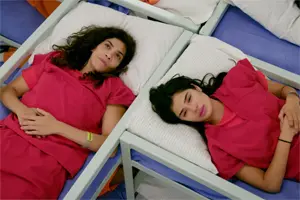Orange Is the New Black writers visited an ICE facility to prep for tackling the immigration crisis
-

Creator Jenji Kohan originally wanted to focus on ICE detention centers in Season 6. Instead, she and her writers used the Season 6 finale to set up the immigration-themed seventh and final season. To prepare, the show's writers visited an ICE detention facility with the advocacy group Freedom for Immigrants. “I don’t think they bothered to Google us because I don’t think there’s any way they would let us in if they had,” said executive producer Carolina Paiz of the May 2018 visit to the Adelanto ICE Processing Center, the largest detention center in Southern California. “We took a bus and drove two hours to the most depressing place in the world.” Paiz, whose Guatemalan mother gave birth to her in Miami to ensure she'd be a U.S. citizen, said what the writers saw that day helped inspire the seventh and final season. "We know prisons and we imagined it was going to be like camp, like a minimum-security prison, but looser than that,” Paiz said. “What shocked us was that it was no different than a maximum-security prison, except that they have less rights. They have no right to an attorney. They have no right to a phone call. It was the most horrifying realization for people who already have worked within that world to realize that it gets darker...When we left there, we all had migraines. We all got sick.” But the research on the immigration-themed season didn't stop there. Legal experts and ex-prisoners spoke to the writers' room. Some writers even attended removal hearings. “We did so much research, we read so much, we talked to so many people, and we talked about these stories so much in the room that it became normal for me to cry three times a day,” said Paiz. “It was like, If Carolina’s not crying, the story’s not working. It just became a normal part of our life to be in grief about what was happening and how bad the situation was getting.” the writers' had 20 potential immigration storylines, but some were rejected after similar stories appeared in the news. “We would write these really sad, terrible scenes and then give them to our consultant to see if it felt real and she would say that it was actually worse than we were describing it,” Paiz said. “A lot of these stories were overwhelming in their tragedy and we wanted to find the right balance.”
ALSO:
- Diane Guerrero on returning for the final season: "I saw the seeds planted with Blanca and all I could do is say, 'Please tell this story and I hope that I’m a part of it.' And they called. Immigration and detention centers are multiplying in this country and with what we’ve seen at the border and the separation of families and our current administration's inhumane laws, I thought it was super important to tell this story as Maritza."
- Laura Gómez says the Season 6 finale was as much as shock to her as it was for viewers: “Season 7 is the only time where I knew in advance what they were sort of planning to finish with,” she says. “At the end of season six I knew that something was building up because the writing in a lot of places felt edgy and dangerous. I just didn't have any idea that it would be this, um, complex.”
- OITNB's production designer Malchus Janocko wanted to set the ICE detention center apart visually: “With the privatization of all of these facilities in our show and in reality, they are obviously looking for the cheapest possible and fastest ways of dealing with things."
- OITNB dedicated a final season episode to makeup department head Karen Reuter, who died one month before filming wrapped
- Read an oral history of OITNB: Author Piper Kerman recalls Ryan Murphy originally having the rights to her book
- OITNB could've had a meta ending with Jenji Kohan pitching Piper's story to Netflix
- Danielle Brooks weighs in on Taystee's OINTB fate
- How that final season flashback came together
TOPICS: Orange Is the New Black, Netflix, Carolina Paiz, Danielle Brooks, Diane Guerrero, Jenji Kohan, Laura Gómez, Malchus Janocko, Piper Kerman, Immigration and TV, Production Design
